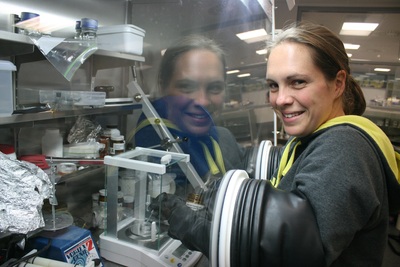Student develops portable X-ray system
An X-ray imaging system developed by Victoria University researcher Nicola Winch could open the way for X-rays to be carried out in a range of new environments.
The portable unit - a self-contained imaging system which Nicola developed as part of her doctoral research - could be used where medical emergencies are happening, by vets working outdoors and for testing in remote locations.

“If there was an earthquake, for example, and a hospital power system failed, this unit could be used for accident and emergency X-ray imaging as the basis of triaging decisions for victims. It is also suited to outdoor veterinary work, and materials testing of pipelines and powerlines in remote areas,” says Nicola.
Nicola’s PhD research investigates the development of new transparent materials for high-resolution radiography.
Traditional X-ray images are stored on photographic film, but increasingly radiographers favour modern techniques such as those based on new storage phosphor imaging plates which don’t require the use of chemicals and where the image is obtained using optical technology.
“We were looking at ways of making these phosphor imaging plates more cost-effective and with higher resolution, for applications in mammography, for example,” she says. “The way to do this is to make transparent plates.
“The older imaging plates are simply a special X-ray sensitive powder ground up and embedded in a resin. These have problems with image detail (resolution) because the light that is used to read out the image strikes the powder grains and is scattered, resulting in a blurred image.
“The transparent plates reduce this problem and result in much better quality images.”
Nicola built the mobile X-ray box because she needed something to test the plates on.
“It has been used to take images, including some of animals, with a high degree of success. The image appears on a laptop computer and can easily be processed and archived, and also transmitted to a base station through the mobile phone network.
“More work needs to be done to reduce the required X-ray dose a little further to fully comply with current medical imaging standards, but it is fine as is for veterinary and materials testing.”
Nicola says the system has many benefits.
“It is lightweight, very portable, easy to use, robust, it can run off batteries and it’s cost-effective as it uses easily obtainable components.”
Associate Professor Andy Edgar, who supervised Nicola’s research, adds: “The system Nicola has built has the potential for widespread use wherever there is a need for portability and independence of mains power in X-ray imaging.
“We are using her work as the foundation for further refinements of both system and plates with a view to commercial development.”
Do a young worker safety check-up this NSW Youth Week
With more than 15,000 of the state's 25-and-unders injured each year, SafeWork NSW is urging...
2025 Champions of Safety Awards nominations close 4 April
Nominations for the 2025 Champions of Safety Awards — an initiative by the Workplace Health...
Move to make SafeWork NSW "a regulator with teeth"
NSW has passed legislation to officially establish SafeWork NSW as a standalone regulator —...










